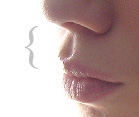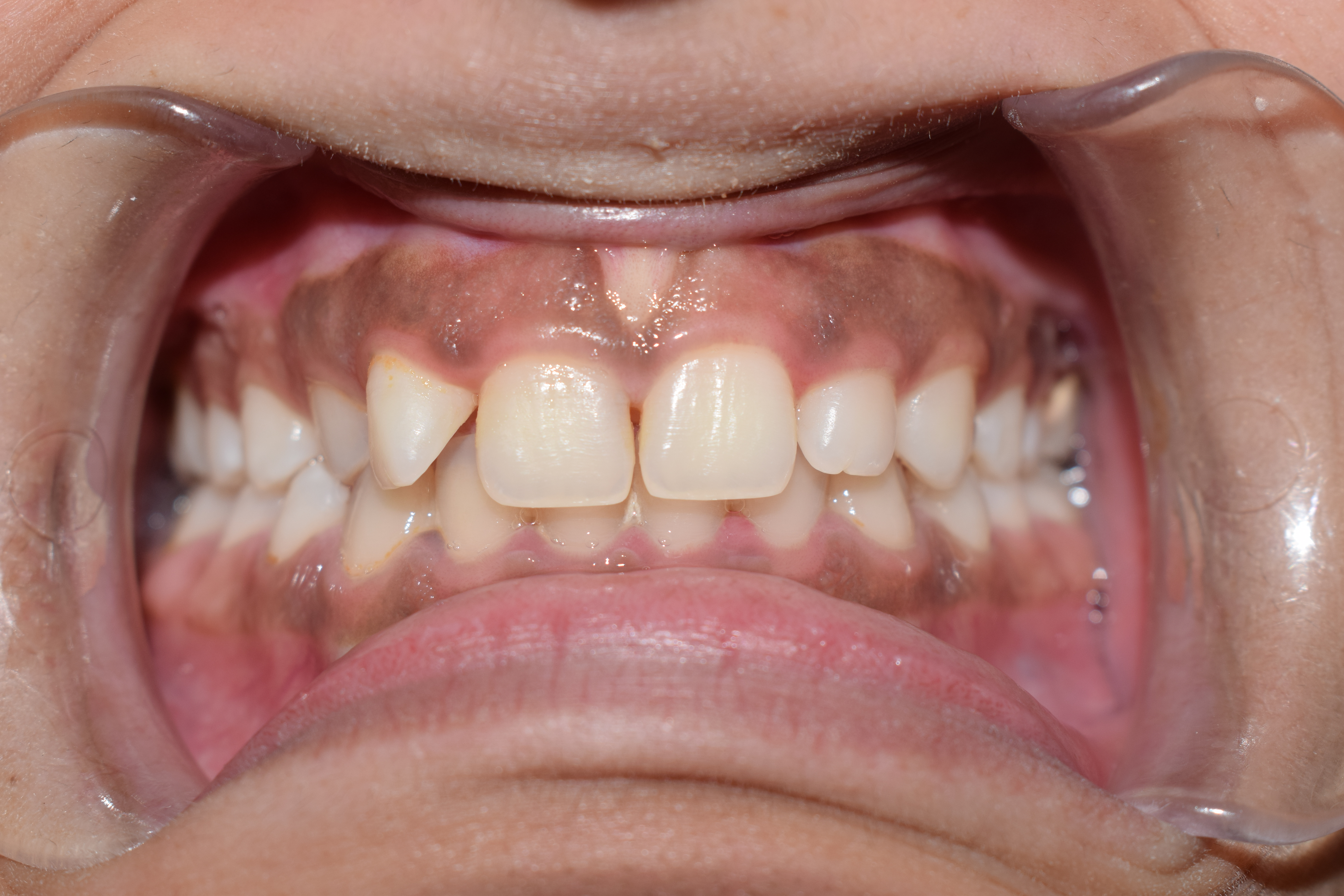|
Jestrum Piercing
A jestrum piercing, also known as a vertical medusa, is an upper lip piercing that is very similar to a labret piercing, or more specifically a vertical labret piercing. It is placed in the philtrum of the upper lip, directly under the nasal septum. Unlike the similar medusa piercing, a jestrum piercing uses a curved bar-bell, and both ends of the piercing are visible externally with the lower part of the bar-bell curving around the underside of the upper lip. Sometimes it is combined with a lower labret piercing to form a symmetrical look. Incorrect jewelry and improper placement can lead to gum and tooth A tooth ( : teeth) is a hard, calcified structure found in the jaws (or mouths) of many vertebrates and used to break down food. Some animals, particularly carnivores and omnivores, also use teeth to help with capturing or wounding prey, tear ... erosion, and other problems associated with oral piercings. References External linksEncyclopedia entry on the jestrum Body ... [...More Info...] [...Related Items...] OR: [Wikipedia] [Google] [Baidu] |
Medusa Piercing
A philtrum piercing, nicknamed a medusa piercing, is an upper lip piercing placed in the philtrum, directly under the septum of the nose. It is typically pierced using a labret A labret is a form of body piercing. Taken literally, it is any type of adornment that is attached to the lip (labrum). However, the term usually refers to a piercing that is below the bottom lip, above the chin. It is sometimes referred to as a ... stud as jewelry, with the ball sitting outside the mouth in the dip of the top lip. A variation of the philtrum piercing is a jestrum, where the piercing is placed vertically through the lip using curved barbell so both beads are visible. The other variation is called double because it features two pierced spots in a line. References External linksEncyclopedia entry on the medusa: Body Modification E-Zine {{Body Piercing Facial piercings de:Labret-Piercing#Medusa-Piercing ... [...More Info...] [...Related Items...] OR: [Wikipedia] [Google] [Baidu] |
Philtrum
The philtrum ( la, philtrum from Ancient Greek ''phíltron,'' lit. "love charm"), or medial cleft, is a vertical indentation in the middle area of the upper lip, common to therian mammals, extending in humans from the nasal septum to the tubercle of the upper lip. Together with a glandular rhinarium and slit-like nostrils, it is believed to constitute the primitive condition for at least therian mammals. Monotremes lack a philtrum, though this could be due to the specialised, beak-like jaws in living species. Function In most mammals, the philtrum is a narrow groove that may carry dissolved odorants from the rhinarium or nose pad to the vomeronasal organ via ducts inside the mouth. For humans and most primates, the philtrum survives only as a vestigial medial depression between the nose and upper lip. The human philtrum, bordered by ridges, is also known as the ''infranasal depression'', but has no apparent function. That may be because most higher primates rely more on vision ... [...More Info...] [...Related Items...] OR: [Wikipedia] [Google] [Baidu] |
Labret Piercing
A labret is a form of body piercing. Taken literally, it is any type of adornment that is attached to the lip (labrum). However, the term usually refers to a piercing that is below the bottom lip, above the chin. It is sometimes referred to as a "tongue pillar" or a "soul patch piercing". Pronunciation The traditional pronunciation of ''labret'' in anthropology is . It derives from the Latin ''labrum'' "lip" and the diminutive suffix ''-et.'' However, many in the body-piercing industry give it the pseudo-French pronunciation , though the French word is in fact borrowed from the English.''How do YOU Say L-a-b-r-e-t?'' (note: the etymology here is false.) Anthropology The labret was a traditional piercing among the American Northwest Coast Indians, where it was related t ...[...More Info...] [...Related Items...] OR: [Wikipedia] [Google] [Baidu] |
Philtrum
The philtrum ( la, philtrum from Ancient Greek ''phíltron,'' lit. "love charm"), or medial cleft, is a vertical indentation in the middle area of the upper lip, common to therian mammals, extending in humans from the nasal septum to the tubercle of the upper lip. Together with a glandular rhinarium and slit-like nostrils, it is believed to constitute the primitive condition for at least therian mammals. Monotremes lack a philtrum, though this could be due to the specialised, beak-like jaws in living species. Function In most mammals, the philtrum is a narrow groove that may carry dissolved odorants from the rhinarium or nose pad to the vomeronasal organ via ducts inside the mouth. For humans and most primates, the philtrum survives only as a vestigial medial depression between the nose and upper lip. The human philtrum, bordered by ridges, is also known as the ''infranasal depression'', but has no apparent function. That may be because most higher primates rely more on vision ... [...More Info...] [...Related Items...] OR: [Wikipedia] [Google] [Baidu] |
Nasal Septum
The nasal septum () separates the left and right airways of the Human nose, nasal cavity, dividing the two nostrils. It is Depression (kinesiology), depressed by the depressor septi nasi muscle. Structure The fleshy external end of the nasal septum is called the Human nose#Cartilages, columella or columella nasi, and is made up of cartilage and soft tissue. The nasal septum contains bone and hyaline cartilage. It is normally about 2 mm thick. The nasal septum is composed of four structures: * Perpendicular plate of ethmoid bone * Vomer bone * Septal nasal cartilage * Maxillary bone (the crest) The lowest part of the septum is a narrow strip of bone that projects from the maxilla and the Palatine bone, palatine bones, and is the length of the septum. This strip of bone is called the maxillary crest; it articulates in front with the septal nasal cartilage, and at the back with the vomer. The maxillary crest is described in the anatomy of the nasal septum as having a maxill ... [...More Info...] [...Related Items...] OR: [Wikipedia] [Google] [Baidu] |
Gingiva
The gums or gingiva (plural: ''gingivae'') consist of the mucosal tissue that lies over the mandible and maxilla inside the mouth. Gum health and disease can have an effect on general health. Structure The gums are part of the soft tissue lining of the mouth. They surround the teeth and provide a seal around them. Unlike the soft tissue linings of the lips and cheeks, most of the gums are tightly bound to the underlying bone which helps resist the friction of food passing over them. Thus when healthy, it presents an effective barrier to the barrage of periodontal insults to deeper tissue. Healthy gums are usually coral pink in light skinned people, and may be naturally darker with melanin pigmentation. Changes in color, particularly increased redness, together with swelling and an increased tendency to bleed, suggest an inflammation that is possibly due to the accumulation of bacterial plaque. Overall, the clinical appearance of the tissue reflects the underlying histology, b ... [...More Info...] [...Related Items...] OR: [Wikipedia] [Google] [Baidu] |
Tooth
A tooth ( : teeth) is a hard, calcified structure found in the jaws (or mouths) of many vertebrates and used to break down food. Some animals, particularly carnivores and omnivores, also use teeth to help with capturing or wounding prey, tearing food, for defensive purposes, to intimidate other animals often including their own, or to carry prey or their young. The roots of teeth are covered by gums. Teeth are not made of bone, but rather of multiple tissues of varying density and hardness that originate from the embryonic germ layer, the ectoderm. The general structure of teeth is similar across the vertebrates, although there is considerable variation in their form and position. The teeth of mammals have deep roots, and this pattern is also found in some fish, and in crocodilians. In most teleost fish, however, the teeth are attached to the outer surface of the bone, while in lizards they are attached to the inner surface of the jaw by one side. In cartilaginous fish, s ... [...More Info...] [...Related Items...] OR: [Wikipedia] [Google] [Baidu] |

.jpeg)


